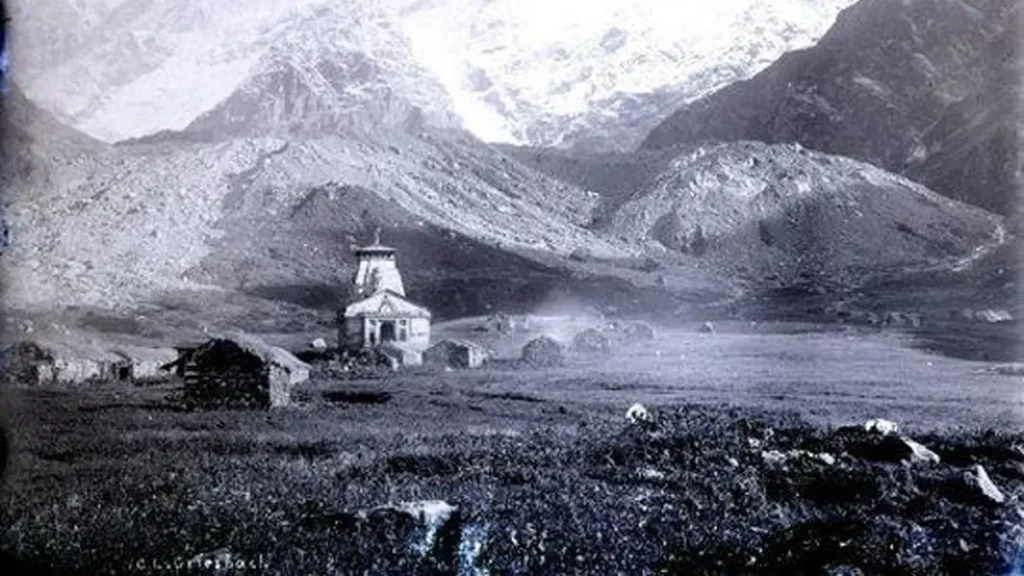
The real history of Kedarnath is not a tale about an old temple. It’s a story of how nature, religion, and miracles have created one of the most charismatic shrines on this planet. Read until the end—the secret of Kedarnath survival and mystique will leave you amazed.
How It All Began—Legends Born at Kedarnath
Kedarnath’s history, so it was said, began thousands of years ago.
The Pandavas, according to ancient mythology, had ventured in quest of Lord Shiva following the Kurukshetra war to seek pardon for their unruly conduct.
Lord Shiva did not wish to wage war against them and transformed himself into a bull. During the chase, he descended below the ground and his hump reappeared at Kedarnath. The other portions reappeared at four other places — giving rise to the well-known Panch Kedar.
Subsequently, the sacred temple is said to have been found or re-established by the divine great Adi Shankaracharya in the 8th century. It was one of the holy Char Dham Yatras. Kedarnath has remained a living testament to faith and generosity since then.
Travellers even today feel that time itself stops when in front of the massive stone temple. If you want to witness this holy site, you can visit here by booking our chardham yatra by helicopter.
The Temple That Defied Nature and Time
The temple sits quietly high up in the snowy mountains, about 3,580 meters above the Mandakini River. People believe it was built many centuries ago using big grey stones, each one placed by hand with care and faith. There were no machines back then — only the devotion of those who built it.
Nobody knows who built it, but the rocks have stood for centuries—standing and unbroken.
Instead of being destroyed by disasters such as the floods that destroyed Uttarakhand in 2013, even when disasters appeared, the temple stood strong. A huge rock, Bhim Shila, was said to have rolled down the mountains and crashed at the entrance of the temple. The rock served as a protector and deflected the floodwaters elsewhere. The surrounding town was destroyed, but not the temple. The majority of the pilgrims still have a conviction that Lord Shiva himself guarded his temple in person.
A New Kedarnath Was Born
Since the 2013 flood, there has been a new story for Kedarnath.
The whole region was rebuilt with caution. There was a fresh master plan designed by expert designers and architects. All of it was done with love for nature, love for natives, and for the pilgrims.
The site was redeveloped as a Green Hill Habitat with green material and enhanced drainage facilities.
In fact, it was one of the first Indian yatras to receive the IGBC Platinum Certification for green building.
Improved roads, safer bridges, and new laybys were constructed to make the journey more comfortable. Even a very old bridge, Rambara Bridge, was reconstructed, providing travelers with a safe passage over the Mandakini River.
Year after year, Kedarnath was recovering.
Pilgrims’ Trek—A Challenge to Faith and Heart
Lakhs of pilgrims embark on their trek every year to Kedarnath with tears in eyes and love in hearts.
Over 11.4 lakh devotees had already completed a pilgrimage in 2025 alone, just within seven weeks of the reopening of sites. Not only did they get peace to their soul, but also new life to the hill villages, shops, and hotels.
Almost Rs 300 crore found its way into the local economy through this pilgrimage tour. The shops were opened once more, the families supported, and hope returned to the hills once again.
But the ride is not always easy. Landslides, rains, and frost continue to test every pilgrim. Even helicopters are delayed sometimes by freak storms or fog.
But hope bringing pilgrims to Kedarnath is greater than fear.
Voices from the Mountains — True Stories, True Emotions
Pilgrims’ stories are now a part of Kedarnath folklore.
One pilgrim once said,
“The line was huge, nearly 7 hours for darshan. It was tiring, but as I looked at Lord Shiva, all the pain disappeared.”
A devotee remembered,
“The 11-km walk tested me to the core, but the stillness of the mountains calmed me down like never before.”
All of them also speak about the crowd, cold, and dash — but nevertheless, all the tourists comment alike — as soon as somebody is within the temple, all the trouble is worth it.
All of the above now make up a tale of heavenly courage, love, and patience.
The Climate and Timing — Nature’s Schedule Rules All
The Kedarnath Temple is accessible for a few months of the year.
It usually begins in April or May (on Akshaya Tritiya) and concludes in October or November (on Kartik Poornima).
During the temple’s closed period, Lord Kedarnath’s idol is shifted to Ukhimath, where pooja goes on even in winter.
There is no access mode to the temple premises during any time of the temple closure since the area is still under a thick cover of snow.
In October 2025, the first snow of the season — turning the temple into a white paradise. That was also the end of the travel season.
Weather is subject to abrupt changes with great altitude. Morning sun can be succeeded by an evening snowfall. That’s why pilgrims are recommended to dress warmly, listen to official word, and preplan.
Kedarnath beauty is stunning but has to be respected and waited upon.
The Secret Tests — Merging Spirituality and Nature
The new Kedarnath narrative isn’t about piety as much — it’s about finding a middle ground between religion and nature.
Plastic, pollution, and strain on the weak hillsides go hand in hand with crores of pilgrims who also bring smiles and cash to the hills.
The government and the locals are now attempting to render Kedarnath eco-friendly.
Solar lights, sanitation waste management systems, and better crowd handling are being used to keep the environment of the temple clean.
It is a new form of praying — saving nature is a prayer to Lord Shiva himself.
What Makes Kedarnath So Special Even Today
It is not its myths or its age that have cut so deeply into our imagination — it is its spirit.
Unshaken by flood, snow, earthquake, stands the temple. Broken and remade, grief and happiness, at the same time.
The tales of survival — the Bhim Shila, the floods, pilgrims’ faith — are today again experienced as miracles.
Each traveler feels like there is some sort of divine, unexplainable energy still in the temple.
Faith fills the air, the bells peal more sonorous, even gusts of powerful wind appear to bless.
Kedarnath in all sense isn’t a location — it’s an experience.
The Real Strength of Kedarnath — Something More Than a Temple
Kedarnath has come to be referred to as the convergence of religion, courage, and creation.
The temple teaches us that human spirit can regrow again after each fall.
The mountains teach us that nature can be gentle but harsh.
The pilgrims teach us how love and dedication can touch the hearts of individuals for decades.
Kedarnath is where hope rekindles, tears fall, and prayers are whispered.
Its past is not read in books — it’s lived with every single beat of the pilgrims’ heart.
The Experience That Awaits Every Soul
While trekking to Kedarnath, waterfalls surround him, pine forests cover him, and cold mountain air carries him.
Hum of Mandakini River follows him, for the tireless “Har Har Mahadev” echoes his ears in valleys.
Aches transform to peace with every step. The world becomes near and religion becomes permanent with every mile travelled.
And when the temple appears in view at last — regal over snow peaks — the heart gets home.
All pilgrims say the same thing — “The mountain beckoned me.”
And perhaps that is how time and time again Kedarnath history gets interwoven — not by writers, but by hearts of its believers.
Kedarnath history is a narrative that had been conceived in imagination by myths, defined by nature, and guarded by religion.
It is said to have been constructed by the hands of gods, lost once more by saints, and reformed by love.
Despite battered by floods and tragedies, Kedarnath remains — unbreakable ever before.
Millions of hearts travel through it every year, filling hearts with faith, hope, and peace.
From the Pandavas of bygones to present pilgrims, from stone walls to white skies — all and everything in Kedarnath has a story to tell.And that is why Kedarnath is not just remembered — but lived.
It is not a temple. It is a Himalayan heart.


